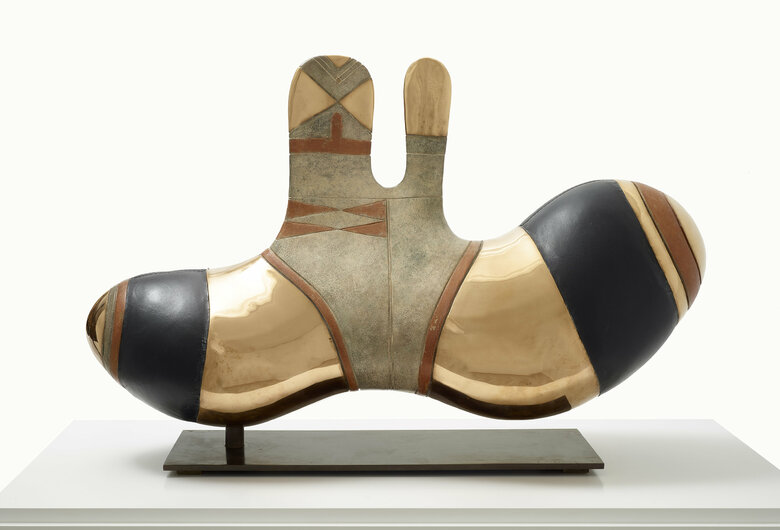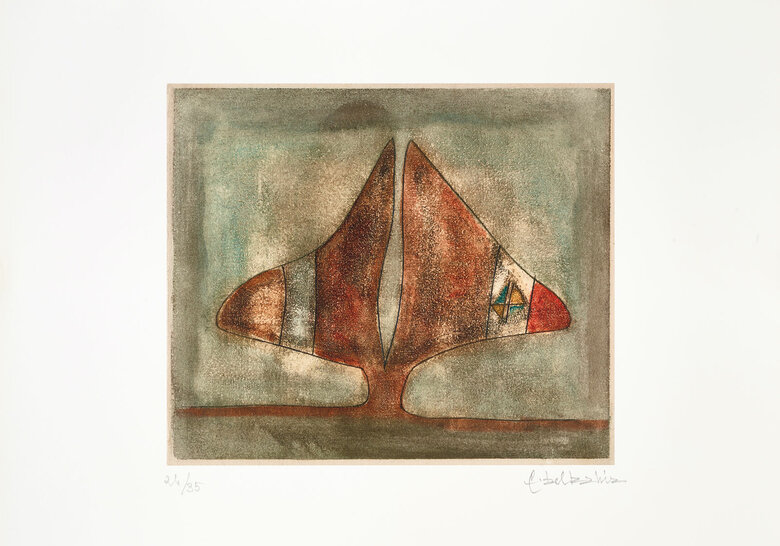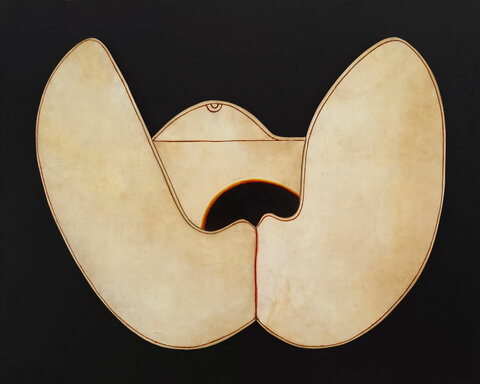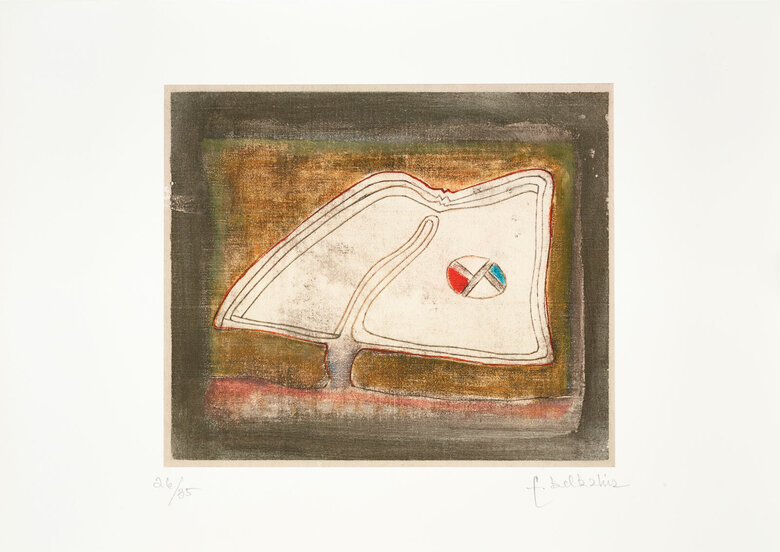Born in 1934 in Marrakech, Morocco, Farid Belkahia belonged to a wealthy, francophone, and Francophile family. His father, M’Hamed Belkahia worked as a civil servant in Civil Control during the...
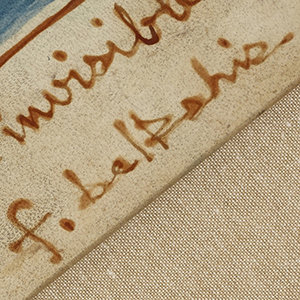

FARID BELKAHIA, Morocco (1934 - 2014)
Bio
Written by ARTHUR DEBSI
Born in 1934 in Marrakech, Morocco, Farid Belkahia belonged to a wealthy, francophone, and Francophile family. His father, M’Hamed Belkahia worked as a civil servant in Civil Control during the French protectorate. He was also part of the Western intellectual, and artistic circles established in the country, frequenting figures like the French artist Nicolas de Staël (1914-19955)[1]. Thus, the young Belkahia early familiarized himself with art, and showed an interest in it to the extent that he produced some oil on canvas portraits at the age of 15 years old[2], with a remarkable Expressionist style. In 1950, alongside the Moroccan artist Moulay Ahmed Drissi (1924-1973), he attended the atelier of the Polish painter Olek Teslar (1900-1952). Yet, his father strictly refused his son to pursue an artistic career, wishing him to study agricultural engineering[3]. Yearning for freedom, he left the house, and went to Ourzazate, where he was a schoolteacher between 1953 and 1954. In 1955, he moved to France, and enrolled in the École Supérieure des Beaux-Arts in Paris, but couldn’t comply with the academic and strict teaching that was provided by the establishment. He consequently joined the atelier of the French painter Raymond Legueult (1898-1971), who would give him more freedom in his artistic practice. In parallel, the student felt this feeling of reconnecting with his roots, and history. He traveled all around the Middle East, visiting Egypt, Baghdad, and Jerusalem, and discovered the richness of Arab, and pre-Islamic cultures. Later on, he decided to both experience life in a communist country, and to acquire deeper knowledge of cinema – a passion that he embraced while living in Paris[4]. In 1959, he went to Prague, Czech Republic, and took courses in scenography at the Prague Theatre Academy. Yet, he returned to Morocco, where he was appointed head of the École des Beaux-Arts in Casablanca in 1962, by Mahjoub Benseddik (1922-2010), the general secretary of the Moroccan Worker’s Union.
Since his childhood, Farid Belkahia was a good sportsman, and even considered athleticism as a career. In 1955, he participated in the 5th edition of the World Festival of Youth and Students in Warsaw, Poland, where he ran along with the famous Czechoslovak athlete Emil Zátopek (1922-2000)[5].
Directed by Maurice Arama (1934-) from 1960 to 1962, the École des Beaux-Arts in Casablanca was founded under the French occupation in 1950[6], and frequented by European students[7]. In 1956, Morocco got independence, and arts played an intricate role in shaping, and asserting the national identity of the country, rich and multicultural. When he took his position as director of the establishment, Farid Belkahia firstly wanted to renovate the educational system and its programs, by giving another approach of teaching plastic art. He insisted on an experimental method, and changed the existing French oriented courses, in order to enhance the Moroccan artistic heritage. He stated: ‘the teaching of discipline [plastic art] must not be done out of certain automatism solely because of the tradition of teaching this material in Europe. (…) Our students are also ignorant of all our plastic art traditions, even though they are an integral part of our culture’[8]. At that time, many Moroccan artists such as Mohamed Chebaa (1935-2013), Mohamed Melehi (1936-2020), and Mohammed Hamidi (1941-), had finished their studies abroad, and successively came to teach at the school. Then, the students could follow specific classes in traditional arts like tapestry, pottery, and Islamic architecture[9].
The oeuvre of Farid Belkahia perfectly embodies this transition, and elaboration of modern Moroccan art, detached from academism, as well as freed from the colonial thought. This is effectively a combination between the search for the origins, and the desire of experimentation. The artist aimed to conciliate the handicraft, with plastic arts: ‘In our country, the industrial production of objects (to take just one example) was originally, artisanal. But with the evolution of modern industrial production, no effort was made to improve the form and quality of the object. (…) The artist can fill this void’[10]. As of the 1970s, Belkahia abandoned the Western conventional techniques like the canvas, and the oil painting[11]. He started using peculiar materials that are part of the Moroccan traditional craft, and especially from the berbere culture. In the imposing art piece Patchwork Culturel (1979), present in the Dalloul Art Foundation’s collection, the artist worked on leather, and with henna, which respectively symbolize a primitive raw medium, and a colorful product. These typical materials also have a sensory value, as Belkahia recalled: ‘the henna, the skin, those are my memories, my grand-mother, the environment I grew up in, the smells that I know…’[12]. The technique celebrates the local habits, and customs, as well as the wide range of symbols that he employed. In the bottom center, he drew a hand tattooed with henna – a recurrent in his art, that indicates the ‘memory of man’[13]. Moreover, he integrated tifinaghs signs, which are used to write the Tamazight languages, which are spoken by the Berbers from North Africa[14].
The strength of the symbols, or the signs, is omnipresent in Farid Belkahia’s reflection towards the quest of origins. He was highly interested in the geometric forms such as the square, the triangle, and the circle, and revealed the multiple interpretations hidden behind them. They are manipulated as universal elements, which surpass the material reality, and materialize the process of creation itself. In the example called Force invisible (1984), also part of the Dalloul Art Foundation’s collection, the painter made a black triangle coming out of the ground. Recalling a mountain, this motif links the earth and the heaven together. Hence, the triangular represents the image of a spiritual elevation of the human. On top of the triangle, two narrows intertwin, and moves to different directions like snakes. The curving lines create a dynamic rhythm, which gives intensity and vibrations to the composition. The artist attended some ceremonies in Morocco, particularly within the African gnawa tribes, and discovered the phenomenon of trance[15]. From this experience, he associated these motions of the body in a trance, with man who is abstract in nature[16].
In the Dalloul Art Foundation’s collection, a series of artworks entitled L’Arbre à Palabres from 2010, demonstrates another key theme, that Farid Belkahia liked to tackle: the tree. In a two-dimensional drawing, he depicted it with a palette of cool colors, and simplified lines, sometimes including tifinaghs signs in the foliage. It is noticeable that the trunk is always in a vertical position, whereas the roots, and branches are very stylized. The motif of the tree is often related to the notion of regeneration, like a repetitive cycle, which invites the viewer to the meditation. It illustrates a state of self-reflectiveness, that the artist associates to the human nature[17].
Farid Belkahia always placed man at the heart of his oeuvre. He conducted research on the relationship between Man and his past, and his culture; through a detailed analytical work of memory. With this rich iconographic vocabulary, the artist delved into the distant origins, involving various historical references. The transmission, and the perpetuation of the traditions – artistic, or social –, on which he shed light, appears to be the way towards self-knowledge. ‘Tradition is the future of mankind’[18], as he said.
Farid Belkahia passed away in Marrakech in 2014.
Notes
[1] Benchemsi, Rajae, Jean Hubert. Martin, and Farid Belkahia. Farid Belkahia. Casablanca, Morocco: Venise Cadre, 2010. [P.236]
[2] Benchemsi, Rajae, and Farid Belkahia. Farid Belkahia. Milano, Italy: Skira, 2013. [P.236]
[3] “Fondation Farid Belkahia.” La Fondation Farid Belkahia. Accessed June 8, 2020. http://fondationfaridbelkahia.com/.
[4] Benchemsi, Rajae, Jean Hubert. Martin, and Farid Belkahia. Farid Belkahia. Casablanca, Morocco: Venise Cadre, 2010. [P.239]
[5] Benchemsi, Rajae, Jean Hubert. Martin, and Farid Belkahia. Farid Belkahia. Casablanca, Morocco: Venise Cadre, 2010. [P.236]
[6] Powers, Jean Holiday. “Published.” Casablanca School - Routledge Encyclopedia of Modernism, 2016. https://www.rem.routledge.com/articles/casablanca-school.
[7] Lakrissa, Fatima Zahra. “École Des Beaux-Arts De Casablanca (1964–1970) - Articles.” bauhaus imaginista. Accessed June 10, 2020. http://www.bauhaus-imaginista.org/articles/2413/e-cole-des-beaux-arts-de-casablanca-1964-1970?0bbf55ceffc3073699d40c945ada9faf=ppq3kadfmlm2tm02ime94tk3q0.
[8] Farid Belkahia in response to the Artists’ Questionnaire, Souffles, nos. 7/8, 1967 conducted in Lenssen, Anneka, A. Rogers, Sarah, and Shabout, Nada. Modern Art in the Arab World, Primary Documents. New York, USA: The Museum of Modern Art, 2018. [P.271]
[9] Benchemsi, Rajae, and Farid Belkahia. Farid Belkahia. Milano, Italy: Skira, 2013. [P.17]
[10] Farid Belkahia in response to the Artists’ Questionnaire, Souffles, nos. 7/8, 1967 conducted in Lenssen, Anneka, A. Rogers, Sarah, and Shabout, Nada. Modern Art in the Arab World, Primary Documents. New York, USA: The Museum of Modern Art, 2018. [P.270]
[11] Eigner, Saeb. Art of the Middle-East, Modern and Contemporary Art of the Arab World and Iran. London, UK: Merell Publishers Limited, 2011. [P.243]
[12] Translated from French : « Le henné, la peau, ce sont mes souvenirs, ma grand-mère, le milieu dans lequel j’ai grandi, les odeurs que je connais… » in Lamlili, Nadia. “Maroc : Farid Belkahia, Dernier Trait De Pinceau – Jeune Afrique.” JeuneAfrique.com. Jeune Afrique, September 26, 2014. https://www.jeuneafrique.com/43555/culture/maroc-farid-belkahia-dernier-trait-de-pinceau/.
[13] Benchemsi, Rajae, Jean Hubert. Martin, and Farid Belkahia. Farid Belkahia. Casablanca, Morocco: Venise Cadre, 2010. [P.65]
[14] Green, Toby. Landscapes, Sources and Intellectual Projects of the West African Past Essays in Honour of Paulo Fernando De Moraes Farias. Leiden, The Netherlands: Brill, 2018. [P.188]
[15] Benchemsi, Rajae, Jean Hubert. Martin, and Farid Belkahia. Farid Belkahia. Casablanca, Morocco: Venise Cadre, 2010. [P.62]
[16] Benchemsi, Rajae, Jean Hubert. Martin, and Farid Belkahia. Farid Belkahia. Casablanca, Morocco: Venise Cadre, 2010. [P.62]
[17] Benchemsi, Rajae, and Farid Belkahia. Farid Belkahia. Milano, Italy: Skira, 2013. [P.102]
[18] Benchemsi, Rajae, Jean Hubert. Martin, and Farid Belkahia. Farid Belkahia. Casablanca, Morocco: Venise Cadre, 2010. [P.44]
Sources
Aroussi, Moulim el., and Brahim Alaoui. Peinture Marocaine 1950-2010: Collection Elisabeth Bauchet-Bouhlal. Marrakech, Morocco: ES-SAADI Garden & Resort, 2010.
Benchemsi, Rajae, and Farid Belkahia. Farid Belkahia. Milano, Italy: Skira, 2013.
Benchemsi, Rajae, Jean Hubert. Martin, and Farid Belkahia. Farid Belkahia. Casablanca, Morocco: Venise Cadre, 2010.
Eigner, Saeb. Art of the Middle-East, Modern and Contemporary Art of the Arab World and Iran. London, UK: Merell Publishers Limited, 2011.
Green, Toby. Landscapes, Sources and Intellectual Projects of the West African Past Essays in Honour of Paulo Fernando De Moraes Farias. Leiden, The Netherlands: Brill, 2018.
Lenssen, Anneka, A. Rogers, Sarah, and Shabout, Nada. Modern Art in the Arab World, Primary Documents. New York, USA: The Museum of Modern Art, 2018.
Powers, Jean Holiday. “Published.” Casablanca School - Routledge Encyclopedia of Modernism, 2016. https://www.rem.routledge.com/articles/casablanca-school.
Sefrioui, Kenza. “La Revue Souffles (1966-1973): Quand Culture Rime Avec Politique.” Revue Interculturel/Francophonie, (Lecce, Alliance Française, n°16), Ss. Dir. Bernoussi Saltani : "Abdellatif Laâbi : Un Intellectuel Tout Simplement", 2009.
Lakrissa, Fatima Zahra. “École Des Beaux-Arts De Casablanca (1964–1970) - Articles.” bauhaus imaginista. Accessed June 10, 2020. http://www.bauhaus-imaginista.org/articles/2413/e-cole-des-beaux-arts-de-casablanca-1964-1970?0bbf55ceffc3073699d40c945ada9faf=ppq3kadfmlm2tm02ime94tk3q0.
Lamlili, Nadia. “Maroc : Farid Belkahia, Dernier Trait De Pinceau – Jeune Afrique.” JeuneAfrique.com. Jeune Afrique, September 26, 2014. https://www.jeuneafrique.com/4...
Farid Belkahia.” La Fondation Farid Belkahia. Accessed June 8, 2020. http://fondationfaridbelkahia.com/.
CV
Selected Solo Exhibitions
2024
Farid Belkahia: Symbols and Forms, Selma Feriani Gallery, Tunis, Tunisia
2021
Farid Belkahia, Centre Georges Pompidou, Paris, France
Contemporary African Art from the permanent collection of the Jordan National Gallery of Fine Arts, The Jordan National Gallery of Fine Arts, Amman, Jordan
Farid Belkahia: The Cosmogonic artist, Selma Feriani Gallery, Tunis, Tunisia
FARID BELKAHIA: GRAPHIC WORKS, PRINTS, ENGRAVINGS, LITHOGRAPHS, SCREEN PRINTS, Dar Tounsi, Marrakech, Morocco
2019
Belkahia Contemporain, Espace Artorium, Casablanca, Morocco
Hommage à la flèche, Farid Belkahia Foundation, Marrakesh, Morocco
2018
Farid Belkahia et l’Ecole des Beaux-Arts de Casablanca 1962-1974 , Farid Belkahia Foundation, Marrakesh, Morocco
2017
L’Entre-monde ou la symbolique de l’arbre chez Farid Belkahia, Farid Belkahia Foundation, Marrakesh, Morocco
2016
L’Arbre à Palabres, Farid Belkahia Foundation, Marrakesh, Morocco
Aube, Mathaf: Arab Museum of Modern Art, Doha, Qatar
2013
L’Atelier de Farid Belkahia, Galerie L’Atelier 21, Casablanca, Morocco
2011
Galerie Venise Cadre, Casablanca, Morocco
Mathaf Contemporary Art Museum, Doha, Qatar
2010
Galerie Delacroix, Tangier, Morocco
2008
Matisse Art Gallery, Marrakesh, Morocco
Exhibition of Drawings, Dar Cherifa, Marrakesh, Morocco
2007
Galerie Le Violon Bleu, Tunis, Tunisia
2005
La dérive des continents, Institut du Monde Arabe, Paris, France
La dérive des continents, Bab Rouah Gallery, Rabat, Morocco
2004
La tradition est le futur de l'homme, Matisse Art Gallery, Marrakesh, Morocco
2001
Marrakesh Museum, Marrakesh, Morocco
1999
Museum of Modern and Contemporary Art, Nice, France
Palais de la Porte Dorée, Paris, France
Musée des Arts d’Afrique et d’Océanie, Paris, France
1998
Galerie Delacroix, Tangier, Morocco
1997
Al Manar Gallery, Casablanca, Morocco
1996
Galerie Motier, Geneva, Switzerland
Procession, Galerie Climat, Paris, France
1995
Darat al Funun, Amman, Jordan
1993
Al Manar Gallery, Casablanca, Morocco
1990
Galerie Erval, Paris, France
1986
Maison des Cultures, Le Havre, France
1985
Batha Museum, Fes, Morocco
1980
Galerie Faris, Paris, France
Fondation Joan Miro, Barcelona, Spain
1979
Cultural Museum, Asilah, Morocco
Documenta Gallery, Copenhagen, Denmark
Spanish Cultural Center, Fes, Morocco
1976
Travelling Exhibition, Rabat, Fes, Meknes, Morocco
1974
Galerie Structure BS, Rabat, Morocco
1972
Galerie Design Steel, Paris, France
1971
Galerie L’Atelier, Rabat, Morocco
1965
Municipal Gallery, Casablance, Morocco
1962
Galerie Bab Rouah, Rabat, Morocco
1958
National Gallery of Damascus, Syria
1955
Galerie Mamounia, Rabat, Morocco
1953
Marrakesh, Morocco
Selected Group Exhibitions
2024
Arab Presences: Modern Art And Decolonisation: Paris 1908-1988, Musée d'Art Moderne de Paris, Paris, France
Prints and Printmaking, Dalloul Art Foundation, Beirut, Lebanon
Casablanca Art School. a Postcolonial Avant-Garde 1962–1987, Schirn Kunsthalle, Frankfurt, Germany
Amur Yakus. Inaugural Exhibition, Loft Art Gallery, Marrakech, Morocco
2023
The Casablanca Art School, Tate St. Ives, UK
2022
Mini Mighty, Fann A Porter, Dubai, United Arab Emirates
Taking Shape: Abstraction from the Arab World, 1950s–1980s, The Block Museum, Evanston, Chicago, Illinois, USA
2021
Art, a serious game, MACAAL, Museum of African Contemporary Art Al Maaden, Marrakech, Morocco
Leads & Artistic Cues from the Arab World, Dalloul Art Foundation (DAF), Beirut, Lebanon
2020
Taking Shape: Abstraction from the Arab World, 1950-1980s, Grey Art Gallery, New York, US
Maroc: Une Identité Moderne, Institut du Monde Arabe, Tourcoing, France
2019
Prête-moi ton rêve, Villa d’Anfa, Casablanca, Morocco
2018
A Century in Flux, Sharjah Art Museum, Sharjah, UAE
Revolution Generations, Mathaf: Arab Museum of Modern Art, Doha, Qatar
2017
Beloved Bodies II, Barjeel Art Foundation, Sharjah, UAE
E-Mois, Autobiography of a Collection, Museum of African and Contemporary Art, Marrakesh, Morocco
Mathaf Collection Summary, Part 2, Mathaf: Arab Museum of Modern Art, Doha, Qatar
Around The World Through Tondos, Galerie Claude Lemand, paris, France
2016
The Sea Suspended, Tehran Museum of Contemporary Art, Tehran, Iran
Beloved Bodies, Barjeel Art Foundation, Sharjah, UAE
Yesterday is tomorrow's memory: a group show of works from North Africa, Al Marsa Gallery, Al Serkal Avenue, Dubai
Focus: Works from Mathaf Collection, Vol 2 Mathaf: Arab Museum of Modern Art, Doha, Qatar
2015
Focus: Works from Mathaf Collection, Mathaf: Arab Museum of Modern Art, Doha, Qatar
Modern Arab Masterpieces, ESPACE CLAUDE LEMAND, Paris, France
2014
1914-2014 One Hundred Years of Creation, Musée Mohammed VI d’Art Moderne et Contemporain, Rabat, Morocco
Le Maroc Contemporain, Institut du Monde Arabe, Paris, France
Sky Over The East, Emirates Palace, UAE
MATHAF COLLECTION SUMMARY, PART 1, Mathaf: Arab Museum of Modern Art, Doha, Qatar
2013
Modernités Plurielles, Centre Pompidou, Paris, France
Tajreed-A SELECTION OF ARAB ABSTRACT ART 1908 – 1960, Contemporary Art Platform Kuwait city, Kuwait
Paintings, Sculptures & Projects Garden, Mathaf: Arab Museum of Modern Art, Doha, Qatar
2012
Musée Lentos, Linz, Austria
Dessins, Galerie L’Atelier 21, Casablanca, Morocco
Le Corps découvert, Institut du Monde Arabe, Paris, France
2010
Interventions, Mathaf: Arab Museum of Modern Art, Doha, Qatar
2008
Morocco, Fundacao Armando Alvares Penteado, Sao Paolo, Brazil
Lentos Musuem, Linz, Australia
2007
Art inspired by poetry Darat Al Funun, Amman, Jordan
2006
Word Into Art, The British Museum, London, UK
2005
La Dérive des Continents, Institut du Monde Arabe, Paris, France
2002
Musée de Marrakech, Morocco
2001
Journey through the Contemporary Arts of the Arab World THE MAGHREB: TUNISIA, ALGERIA AND MOROCCO, Darat Al Funun, Amman, Jordan
2000
Biennale de Lyon, La Veinerie, France
1998
African Artists, Tobu Musuem, Tokyo, Japan
Mediterranea, Musée d’Hotel de Ville, Brussels, Belgium
Autour du Foot, Galerie Enrico Navarra, Paris, France
1997
Modernity and Memories, Venice Biennial, Italy
Méditations, Medresa Ben Youssef, Marrakesh, Morocco
1995
Vital: Three Contemporary African Artists, Tate Liverpool, Liverpool, UK
House of World Cultures, Berlin, Germany
Geneva, Switzerland
1994
Rencontres Africaines, Institut du Monde Arabe, Paris, France
1993
Painters of the Maghreb, Travelling Exhibition, Spain
1992
Al Manar Gallery, Casablanca, Morocco
1991
Quatre peintres du Maroc, Institut du Monde Arabe, Paris, France
1988
Peinture Contemporaine Marocaine, Brussels, Belgium
1987
Biennale de Sao Paolo, Brazil
1985
Twenty-Five Years of Drawing, Alif Ba Gallery, Casablanca, Morocco
Présences Artistiques du Maroc, Maison de la Culture, Grenoble, France
1981
Nadar Gallery, Casablanca, Morocco
1980
Salon de Mai, Paris, France
1978
Iraqi Cultural Center, London, UK
1974
First arab Biennial, Baghdad, Iraq
1973
Les Peintres Maghrébin, Algeria
1972
Paly Group International, New York, US
1969
Exposition Manifeste, Place du 16 Novembre, Casablance, Morocco
Exposition Manifeste, Djemaa al-Fna, Marrakech Morocco
1967
Panafrican Festival, Algiers, Algeria
Municipal Gallery, Casablanca, Morocco
1966
Belkahia, Chebaa, Melehi, Hall du Théatre Mohammed V, Rabat, Morocco
1964
Terres des Hommes, International Festival, Montreal, Canada
1963
2000 ans d’art du Maroc, Galerie Charpentier, Paris, France
Recontres Internationale des artistes, Morocco
1961
Biennale de Paris, France
1959
Biennale de Paris, France
1958
Washington D.C, US
1957
Tunis, Tunisia
1956
Biennial of Alexandria, Egypt
7th
Salon d’Hiver du Maroc, Marrakesh, Morocco
1955
Salon d’Automne, Gallery Gallieni, Casablanca, Morocco
Collections
Mathaf Farid Belkahia, Marrakesh, Morocco
Ramzi and Saeda Dalloul Art Foundation, Beirut, Lebanon
Mathaf: Arab Museum of Modern Art, Doha, Qatar
Barjeel Art Foundation, Sharjah, UAE
Institut du Monde Arabe, Paris, France
The British Museum, London, UK
Fundacion Banco Santander, Madrid, Spain
Centre Pompidou, Paris, France
Musée Mohammed VI d’Art Moderne et Contemporain, Rabat, Morocco
Museum of African and Contemporary Art, Marrakesh, Morocco
The Khaled Shoman Collection, Darat Al Funun, Amman, Jordan
Jordan National Gallery of Fine Arts, Amman, Jordan
Tate Modern, London, UK
Documents
L’Atelier de Farid Belkahia
Galerie d'art L'Atelier 21
French, 2013
Catalogue
Farid Belkahia: Artiste et animateur propos recuellis
Dominique Desanti and Jean Decock
UCLA James S. Coleman African Studies Center, French, 1969
Essay
Project MUSE - Farid Belkahia: Eroticism in Malhoun
Rajae Benchemsi, Salah Hassan, Lucy Thairu
Duke University Press, English, 2001
Moroccan Modernism: The Casablanca School (1956-1978)
Jean Powers
Cornell University, English, 2015
Le régime postcolonial des arts et les usages de la modernité
Rachida Triki
Rue Descartes , French, 2007
pages 104 à 111
The Magic of Signs and Patterns in North African Art
Salwa Mikdadi
Heilbrunn Timeline of Art History, English, 2004
Visual Arts in the Kingdom of Morocco
Samir El Azhar
Third Text, English, 2016
Taking Moroccan Art to the Streets: Ephemeral Engagement and Sustained Community Practices
Katarzna Piepzrak
Sternberg Press, English/French, 2012
MarrakechBiennale6_Booklet-2.pdf
The Casablanca School of Fine Arts
Marrakach Biennale 6, English/French, 2016
MarrakechBiennale6_Booklet-3.pdf
Ecole de Casablanca مدرســــة الدارالبيضـــــاء
Marrakach Biennale 6, English/Arabic, 2016
MarrakechBiennale6_Booklet-4.pdf
The Casablanca School of Fine Arts: Belkahia, Chabâa, Melehi and the Fabrication of Art and History
Marrakach Biennale 6, English/French, 2016
Born in 1934 in Marrakech. Died in 2014 in Marrakech. Né en 1934 à Marrakech. Mort en 2014 à Marrakech. ولد عام ١٩٣٤ وتوّفي عام ٢٠١٤ في مراكش..pdf
The Casablanca School of Fine Arts
Marrakach Biennale 6, English/French, 2016
MODERNITÉS PLURIELLES UNE NOUVELLE HISTOIRE DE L'ART MODERNE DE 1905 À 1975
Véronique Missud
Centre Georges Pompidou, French, 2014
Farid Belkahia Modernité de la tradition
Nagham Hodaifa
Centre culturel du livre Édition / Distribution, French, 2020
Decolonizing Culture: Third World, Moroccan, and Arab Art in Souffles/Anfas, 1966-1972*
Claire Davis
Essays of the Forum Transregionale Studien, English, 2015
Farid Belkahia und die Avantgarde
Ronja Merkel
Ludwig-Maximilians-Universitä, German, 2017
Press
Farid Belkahia, epidermique et intransigeant
Diptych, French, 2020
Tourcoing: Une exposition célèbre l’École de Casablanca
Fadwa Miadi
Le courier de l'atlas, French, 2020
UNE SCULPTURE DE FEU FARID BELKAHIA INSTALLÉE DEVANT LE MUSÉE MOHAMMED VI D'ART MODERNE ET CONTEMPORAIN
Le 360 Ma, French, 2020
A work of Moroccan artist Farid Belkahia sold for more than MAD 830.000 at auction in London
Ya Biladi, English, 2020
Préface à un livre sur l’École de Casablanca : Documents, supports, montages
MACAAL, French, 2019
Belkahia, celui qui a révolutionné l’art au Maroc
Joséphine Adam
L'Economiste, French, 2018
Maroc : dans l’ancien atelier de Farid Belkahia
Nicolas Michel
Jeune Afrique, French, 2019
L'exposition "prête-moi ton rêve" fait le tour du continent africain.
BBC News, French, 2019
« Prête-moi ton rêve », le pari d’une exposition itinérante panafricaine
Roxana Azimi
Le Monde, French, 2019
Exposition: "Prête-moi ton rêve"s'invite à Casablanca
Media 24, French, 2019
« Prête-moi ton rêve », une exposition itinérante du Maroc à l’Afrique du Sud
Nicolas Michel
Jeune Afrique, French, 2019
L’Artorium ou l’histoire de l’art à portée de main
Amine BOUSHABA
L'Economiste, French, 2018
تقديم وتوقيع كتابين حول الفنان التشكيلي فريد بلكاهية بمراكش
scoopress, Arabic, 2018
Marrakech célèbre la verve érotique du peintre Farid Belkahia
Roxana Azimi
LE MONDE, French, 2016
افتتاح متحف فريد بلكاهية بمراكش
Nisrine Al Naji
Le 360 Ma, Arabic, 2016
Le top 8 des oeuvres marocaines les plus chères
Kaouthar Oudrhiri
Telquel.ma, French, 2016
فريد بلكاهية عاد إلى «مدينة النحاس»
Mohammed Al Khodayri
Al Akhbar, Arabic, 2014
رحيل الفنان التشكيلي المغربي فريد بلكاهية
Ibrahim Al Hujari
Al Jazeera, Arabic, 2014
Farid Belkahia, un géant nous a quittés!
Samir El Ouardighi
Media 24, French, 2014
INAUGURATION À MARRAKECH DU "MUSÉE FARID BELKAHIA"
360 MA, French, 2016
Art contemporain: Le musée Farid Belkahia ouvrira ses portes en février à Marrakech
Huff post Maghreb, French, 2016
Farid Belkahia, un patrimoine inédit
Toni MARAINI
L'Economiste, French, 2016
Farid Belkahia Cuba Si 1961
Morad Montazami
Tate Modern, English, 2015
An Artwork in Detail : ‘Main’ by Farid Belkahia
One woman many hats, English, 2015
فريد بلكاهية.. التشكيلي المروض للون والمادة
Chafik Al Zakari
Maghress, Arabic, 2014
Une oeuvre de Farid Belkahia acquise par le Centre Pompidou à Paris
Aujoud'hui le Maroc, French, 2013
La dérive des continents selon Farid Belkahia
Abdelhak Najib
Maghress, French, 2005
L'artiste Farid Belkahia expose à L'Atelier 21
Medias 24, French, 2013
Exposition à l’Atelier 21 à Casablanca : « Dans l’atelier de l’artiste » Farid Belkahia
La Tribune, French, 2013
L’Entre-monde ou la symbolique de l’arbre chez Farid Belkahia
Jean Marc Lebeaupin
art six mic, French, 2017
Marrakech. Une exposition sur la symbolique de l’arbre dans les œuvres de Farid Belkahia
medias 24, French, 2017
L’Entre-monde» ou la symbolique de l’arbre chez Belkahia
Siham Jadraoui
aujourd'hui Ma, French, 2017
Modernités plurielles 1905-1970
Centre George Pompidou, French, 2013
Maroc: Farid Belkahia, dernier trait de pinceau
Nadia Lamlili
Jeune Afrique, French, 2014
Farid Belkahia on the Musée du Quai Branly in Paris
Daphne Pappers
The Power of culture, English, 2006
Farid Belkahia à la Galerie Bab Rouah : «La dérive des continents» ouvre la saison plastique
Le matin Ma, French, 2005
Exposition de Farid Belkahia à l'IMA : La dérive des continents
Ya Biladi, French, 2005
الفنان التشكيلي فريد بلكاهية يعرض إبداعاته بالرباط
Mostafa Al Osayri
Al Yaum, Arabic, 2005
Journey through the Contemporary Arts of the Arab World THE MAGHREB: TUNISIA, ALGERIA AND MOROCCO
Darat Al Funun, English, 2001
Farid Belkahia: «La tradition est le futur de l'homme»
Kenza ALAOUI
L'Economiste, French, 2001
رحيل الفنان التشكيلي المغربي فريد بلكاهية _ أخبار ثقافة _ الجزيرة نت.pdf
نحن والدولة.pdf
Centre Pompidou, in collaboration with Mathaf, presents Farid Belkahia exhibition in Paris - Gulf Times.pdf
FARID BELKAHIA Artwork

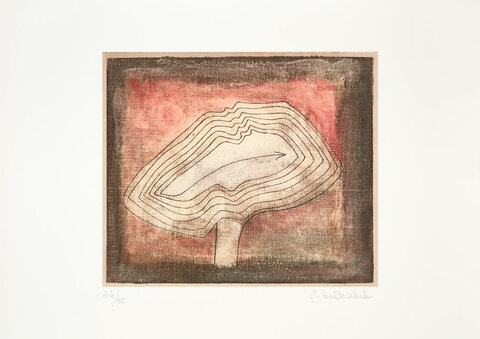
L'Arbre À Palabres (Part of a case of 7 digital prints,an original painting, and a poetry book by Adonis)
FARID BELKAHIA, Morocco, 2010
29 x 34 cm
Become a Member
Join us in our endless discovery of modern and contemporary Arab art
Become a Member
Get updates from DAF
Follow Artists
Save your favourite Artworks
Share your perspectives on Artworks
Be part of our community
It's Free!
We value your privacy
TermsCookiesPrivacy Policies
Become a Member
Get updates from DAF
Follow Artists
Save your favourite Artworks
Share your perspectives on Artworks
Be part of our community
It's Free!
We value your privacy
TermsCookiesPrivacy Policies
Become a Member
Get updates from DAF
Follow Artists
Save your favourite Artworks
Share your perspectives on Artworks
Be part of our community
It's Free!
We value your privacy
TermsCookiesPrivacy Policies
Welcome to the Dalloul Art Foundation
Thank you for joining our community
If you have entered your email to become a member of the Dalloul Art Foundation, please click the button below to confirm your email and agree to our Terms, Cookie & Privacy policies.
We value your privacy, see how
Become a Member
Get updates from DAF
Follow Artists
Save your favourite Artworks
Share your perspectives on Artworks
Be part of our community
It's Free!
We value your privacy
TermsCookiesPrivacy Policies

-FaridBelkahia-Front-(1).jpg)
-FaridBelkahia-Front-(1).jpg)
-Detail.jpg)
-Detail.jpg)
.jpg)
.jpg)
